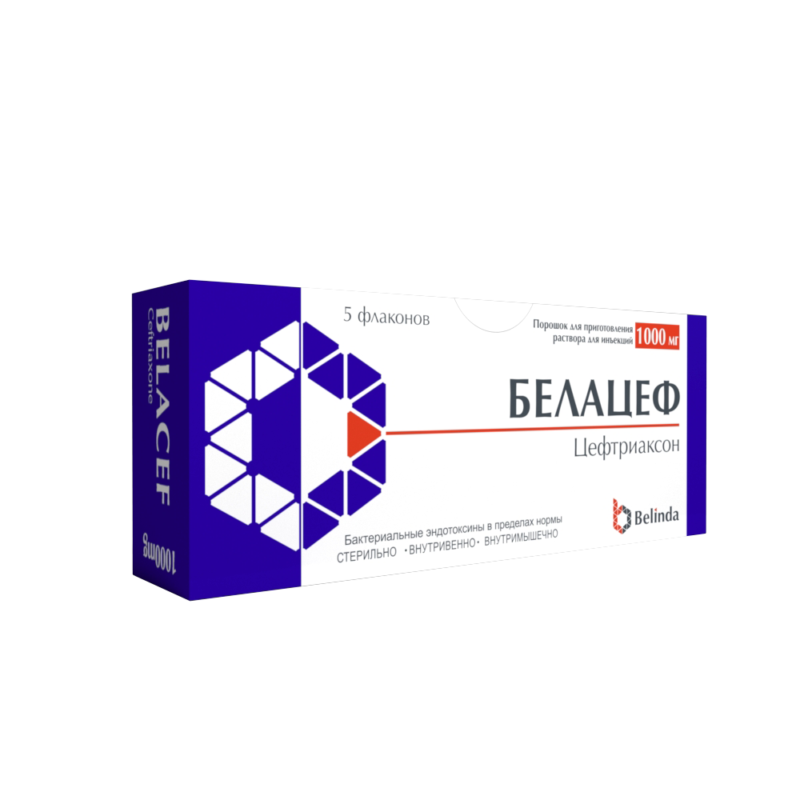
Belacef
Ceftriaxone inhibits bacterial cell wall synthesis after binding to penicillin-binding proteins. As a result, the biosynthesis of the cell wall (peptidoglycan) stops, which leads to the destruction and death of the bacterial cell.
Composition
One bottle contains:
active substance – ceftriaxone sodium 1.193 (equivalent to ceftriaxone 1,000 g)
Indications for use
Infections in adults and children caused by pathogens sensitive to the drug:
– respiratory tract infections (community-acquired, nosocomial pneumonia, exacerbation of chronic obstructive pulmonary disease);
– acute otitis media;
– infections of the abdominal organs (peritonitis, infections of the biliary tract and gastrointestinal tract);
-complicated infections of the kidneys and urinary tract (including pyelonephritis);
-infections of bones or joints (osteomyelitis);
-complicated infections of the skin and soft tissues;
– genital infections, including gonorrhea, syphilis, chancre;
-disseminated Lyme disease (spirochetosis); (II – III stage of the disease);
-sepsis, bacterial meningitis, bacterial endocarditis;
– with typhoid fever;
– with salmonellosis and salmonella carriers;
-preoperative prevention of infectious complications;
fever in neutropenic patients, which is suspected to be caused by a bacterial infection.
Belacef should be prescribed in combination with other antibacterial drugs in cases where the suspected number of pathogens is not included in the spectrum of action of ceftriaxone.
Mode of application
The dose of the drug depends on the severity of the disease, the sensitivity of the pathogen, the patient’s age, the presence of impaired hepatic and renal function in the patient. The recommended doses are the usual doses for the indicated indications. In severe cases, the highest recommended dose (upper limit) should be administered. When treating diseases in patients caused by a combination of bacteria (which is confirmed or suspected), the drug should be administered together with other antibacterial drugs, if the possible range of sensitivity of the causative agent of the disease will not fall into its spectrum.
Special dosing regimens in adults and children over 12 years of age (weighing ≥50 kg)
Acute otitis media: a single dose of 1-2 g of Belacef can be administered intramuscularly, in severe cases or in the absence of success from previous treatment, Belacef can be administered intramuscularly at a dose of 1-2 g per day for 3 days.
Gonorrhea: 500 mg once, intramuscularly.
Syphilis: the usual recommended doses are 500 mg – 1 g once a day (with neurosyphilis, the dose can be increased to 2 g once a day), the duration of treatment is 10-14 days. Dosing recommendations for syphilis, including neurosyphilis, are based on limited data.
Disseminated Lyme borreliosis (early (stage II) and late (stage III): 2 g once a day for 14-21 days (the duration of treatment should correspond to the current guidelines).
Prevention of postoperative infections: depending on the degree of risk of infection, 1-2 g of Belacef is administered once 30-90 minutes before the start of the operation.
Elderly patients: usual doses for adult patients.
Children weighing 50 kg and above are prescribed doses for adults.
Special dosage regimens in newborns, infants and children from 15 days of age to 12 years (with a body weight of ˂50 kg):
Acute otitis media: as a rule, a single dose of 50 mg / kg body weight of Belacef intramuscularly is sufficient. Limited data indicate that in severe cases or in the absence of success from previous treatment, intramuscular administration of Belacef at a dose of 50 mg / kg per day for 3 days may be indicated.
Lyme disease (stage II – III): the recommended dose for children is 50-80 mg / kg, administered once a day for 14-21 days (national treatment recommendations must be taken into account).
Gonorrhea (caused by penicillinase-forming and penicillinase-non-forming strains): a single intramuscular injection of 250 mg of Belacef.
Preoperative prevention of surgical infections: a single dose of 50-80 mg / kg body weight before surgery.
Syphilis: the recommended doses are 75-100 mg / kg of body weight (but not more than 4 g) once a day, the duration of treatment is 10-14 days. Dosage recommendations for syphilis, including neurosyphilis, are based on limited data (national treatment guidelines should be taken into account).
Ceftriaxone is contraindicated in premature infants under 41 weeks of age (gestational age + chronological age).
Special dosing regimens in newborns (0-14 days of life)
Acute otitis media: as a rule, a single intramuscular injection of the drug at a dose of 50 mg / kg body weight is sufficient.
Preoperative prevention of surgical infections: a single dose of 20-50 mg / kg of body weight before surgery.
Syphilis: the recommended dose is 50 mg / kg body weight once a day, the duration of treatment is 10-14 days. Dosage recommendations for syphilis, including neurosyphilis, are based on limited data and national guidelines for the management of these conditions should be taken into account.
The duration of treatment depends on the course of the infectious disease. As always with antibiotic therapy, the administration of Belacef should be continued for at least 48-72 hours after the temperature has returned to normal and the eradication of the pathogen is confirmed.
Special patient groups:
Elderly patients
In the absence of impaired liver and kidney function, the usual doses for adults, without adjustments for age.
In patients with impaired liver function, there is no need to reduce the dose, provided that there is no impaired renal function. There are no data on the use of the drug in severe liver dysfunctions.
In patients with impaired renal function, there is no need to reduce the dose, provided there is no impaired liver function. The daily dose of Belacef should not exceed 2 g only in cases of renal failure with creatinine clearance less than 10 ml / min.
Patients on dialysis do not need additional administration of the drug after dialysis. However, the concentration of ceftriaxone in serum should be monitored for possible dose adjustments, since the rate of excretion in these patients may be reduced.